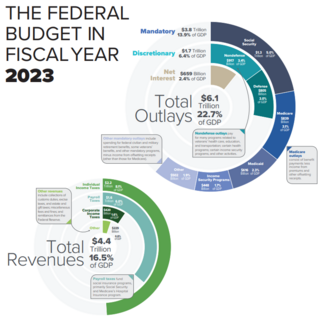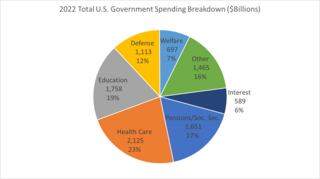An appropriation bill, also known as supply bill or spending bill, is a proposed law that authorizes the expenditure of government funds. It is a bill that sets money aside for specific spending. In some democracies, approval of the legislature is necessary for the government to spend money.
The United States budget process is the framework used by Congress and the President of the United States to formulate and create the United States federal budget. The process was established by the Budget and Accounting Act of 1921, the Congressional Budget and Impoundment Control Act of 1974, and additional budget legislation.
A black budget or covert appropriation is a government budget that is allocated for classified or other secret operations of a state. The black budget is an account expenses and spending related to military research and covert operations. The black budget is mostly classified because of security reasons.
The U.S. Senate Appropriations Subcommittee on Defense is one of twelve subcommittees of the U.S. Senate Committee on Appropriations. Military defense spending is the largest individual component of federal discretionary spending, making the Defense Subcommittee one of the more powerful Appropriations subcommittees. When referring to federal discretionary spending as a whole, many budget analysts make a distinction between defense and non-defense discretionary spending. The United States Senate Committee on Appropriations has joint jurisdiction with the United States House Committee on Appropriations over all appropriations bills in the United States Congress. Each committee has 12 matching subcommittees, each of which is tasked with working on one of the twelve annual regular appropriations bills.

The military budget of the United States is the largest portion of the discretionary federal budget allocated to the Department of Defense (DoD), or more broadly, the portion of the budget that goes to any military-related expenditures. The military budget pays the salaries, training, and health care of uniformed and civilian personnel, maintains arms, equipment and facilities, funds operations, and develops and buys new items. The budget funds six branches of the US military: the Army, Navy, Marine Corps, Coast Guard, Air Force, and Space Force.
PAYGO is the practice in the United States of financing expenditures with funds that are currently available rather than borrowed.
The Low Income Home Energy Assistance Program is a United States federal social services program first established in 1981 and funded annually through Congressional appropriations. The mission of LIHEAP is to assist low income households, particularly those with the lowest incomes that pay a high proportion of household income for home energy, primarily in meeting their immediate home energy needs. The program, part of the United States Department of Health and Human Services (HHS), is funded by grants appropriated from the federal government.

The United States budget comprises the spending and revenues of the U.S. federal government. The budget is the financial representation of the priorities of the government, reflecting historical debates and competing economic philosophies. The government primarily spends on healthcare, retirement, and defense programs. The non-partisan Congressional Budget Office provides extensive analysis of the budget and its economic effects. CBO estimated in February 2024 that Federal debt held by the public is projected to rise from 99 percent of GDP in 2024 to 116 percent in 2034 and would continue to grow if current laws generally remained unchanged. Over that period, the growth of interest costs and mandatory spending outpaces the growth of revenues and the economy, driving up debt. Those factors persist beyond 2034, pushing federal debt higher still, to 172 percent of GDP in 2054.
The budget of the United States government for fiscal year 2007 was produced through a budget process involving both the legislative and executive branches of the federal government. While the Congress has the constitutional "power of the purse", the President and his appointees play a major role in budget deliberations. Since 1976, the federal fiscal year has started on October 1 of each year.

The United States Department of Defense is an executive branch department of the federal government of the United States charged with coordinating and supervising all agencies and functions of the U.S. government directly related to national security and the United States Armed Forces. As of June 2022, the U.S. Department of Defense is the largest employer in the world, with over 1.34 million active-duty service members, including soldiers, marines, sailors, airmen, and guardians. The Department of Defense also maintains over 778,000 National Guard and reservists, and over 747,000 civilians bringing the total to over 2.87 million employees. Headquartered at the Pentagon in Arlington County, Virginia, just outside Washington, D.C., the Department of Defense's stated mission is to provide "the military forces needed to deter war and ensure our nation's security".

The United States federal budget consists of mandatory expenditures, discretionary spending for defense, Cabinet departments and agencies, and interest payments on debt. This is currently over half of U.S. government spending, the remainder coming from state and local governments.

The Consolidated Appropriations Act, 2012 is an act passed by the 112th United States Congress.

Consolidated and Further Continuing Appropriations Act, 2013 was a bill passed by the United States House of Representatives of the 113th United States Congress. The bill prevented a government shutdown and funded the federal government through September 30, 2013 as it replaced a continuing resolution which expired on March 27, 2013.

The Military Construction and Veterans Affairs, and Related Agencies Appropriations Act, 2014 is an appropriations bill that was introduced into the United States House of Representatives during the 113th United States Congress. The bill would appropriate money to various government agencies related to the United States Department of Defense and the United States Department of Veterans Affairs. This funding would be used during fiscal year 2014, which ends September 30, 2014. According to its committee report, "the purpose of the bill is to support our military and their families and provide the benefits and medical care that our veterans have earned for their service." The report also indicated that the Committee had made its decisions with the national debt and budget deficit in mind.
The October 2013 mini-continuing resolutions were a set of continuing resolutions that would have provided funding for a limited set of federal agencies during the United States federal government shutdown of 2013. The bills were part of a Republican strategy to fund portions of the government which have bipartisan support, in order to spare those agencies and programs from the effects of the shutdown. The bills all passed the United States House of Representatives during the 113th United States Congress, but were ignored by the United States Senate. These selective continuing resolutions became moot upon the passage of the Continuing Appropriations Act, 2014 which funded the entire government, ending the shutdown.

In the United States Congress, an appropriations bill is legislation to appropriate federal funds to specific federal government departments, agencies and programs. The money provides funding for operations, personnel, equipment and activities. Regular appropriations bills are passed annually, with the funding they provide covering one fiscal year. The fiscal year is the accounting period of the federal government, which runs from October 1 to September 30 of the following year. Appropriations bills are under the jurisdiction of the United States House Committee on Appropriations and the United States Senate Committee on Appropriations. Both Committees have twelve matching subcommittees, each tasked with working on one of the twelve annual regular appropriations bills.

The National Defense Authorization Act for Fiscal Year 2016 is a United States federal law which specifies the budget and expenditures of the United States Department of Defense (DOD) for Fiscal Year 2016.

Government spending in the United States is the spending of the federal government of the United States and the spending of its state and local governments.

The Consolidated Appropriations Act, 2021 is a $2.3 trillion spending bill that combines $900 billion in stimulus relief for the COVID-19 pandemic in the United States with a $1.4 trillion omnibus spending bill for the 2021 federal fiscal year and prevents a government shutdown. The bill is one of the largest spending measures ever enacted, surpassing the $2.2 trillion CARES Act, enacted in March 2020. The legislation is the first bill to address the pandemic since April 2020. According to the Senate Historical Office, at 5,593 pages, the legislation is the longest bill ever passed by Congress.

Andrew Philip Hunter is an American defense official and policy analyst who is the 14th and current assistant secretary of the Air Force for acquisition, technology and logistics (SAF/AQ). Prior to becoming an Air Force Assistant Secretary, he was the director of the defense industrial initiatives group at the Center for Strategic and International Studies. Before joining CSIS, Hunter spent 15 years as a staffer in the U.S. House of Representatives, and as a senior procurement official at the Department of Defense during the Obama administration.









